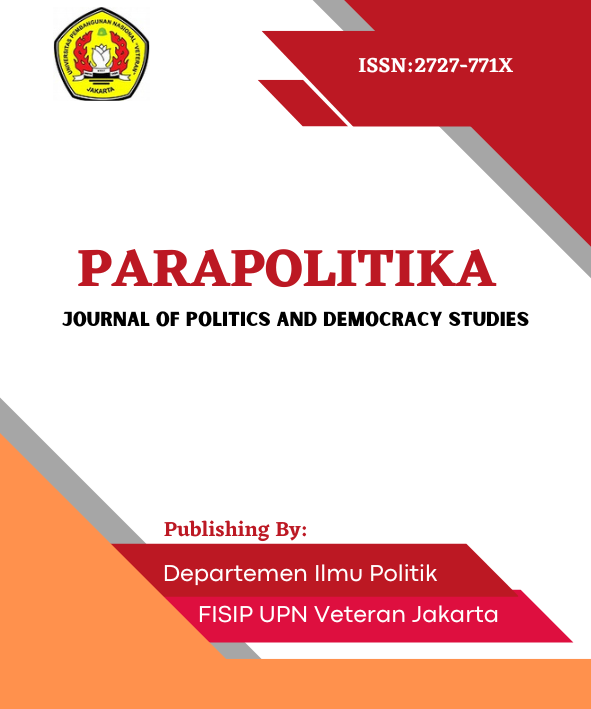KETERWAKILAN POLITIK PEREMPUAN DI PARLEMEN PERIODE 2019-2024: PERAN PARTAI POLITIK
DOI:
https://doi.org/10.33822/jpds.v2i2.5912Keywords:
political parties, gatekeepers, candidacies, women's political representation, women's movement activistsAbstract
Political parties have an important role in efforts to increase women's political representation in parliament. The most significant function of political parties as gatekeepers is to carry out the recruitment, selection and candidacy of candidates for members of parliament in the general election contestation. This study aims to explain both internal and external factors that influence the role of political parties in increasing women's political representation in parliament in the 2019 election. The research method used is literature study by referring to previous research and secondary data sourced from books, journals, online news, and laws and regulations. The findings of this study reinforce previous research that political parties have a major role in efforts to increase women's political representation in parliament. The role of the party refers to the process of recruitment, selection and candidacy of women, the involvement of women in the organizational structure of the party, and the ideology of political parties. The role and policies of political parties in increasing women's representation are also strongly influenced by gender quota policies, electoral systems and party systems, and women's movement activists.
References
Bjarnegård, Elin. 2013. Gender, Informal Institutions and Political Recruitment: Explaining Male
Dominance in Parliamentary Representation. England: Palgrave Macmillan.
Childs, Sarah. 2018. Women and British Party Politics: Descriptive, Substantive and Symbolic
Representation. USA and Canada. Routledge.
Dahlerup, Drude. 2003. Comparative Studies of Electoral Gender Quotas. Paper Presented at
International Idea Workshop, Lima, Peru, 23–24 February 2003.
Dahlerup, Drude. 2005. Women, Quotas and Politics. London: Routledge
Grigsby, Ellen. 2012. Analyzing Politics: An Introduction to Political Science, Fifth Edition. USA:
Wadsworth.
Hague, Rod et.al.2016. Political Science: A Comparative lntroduction (8th edition). USA and
Canada: Palgrave McMillan.
Kittilson, Miki Caul.2006. Challenging Parties, Changing Parliaments: Women and Elected
Office in Contemporary Western Europe. Colombus: The Ohio State University.
Krook, Mona Lena. 2009. Quotas for Women in Politics: Gender and Candidate Selection Reform
Worldwide. New York: Oxford University Press, Inc.
Magstadt, Thomas M.Ph.D. 2013. Understanding Politics: Ideas, Institutions, and Issues, Tenth
Edition. Cengage Learning. Canada: Wadsworth.
Matland, Richard E. Enhancing Women’s Political Participation: Legislative Recruitment and
Electoral Systems, dalam Ballington, Julie dan Karam, Azza (eds). 2005. Women in
Parliament: Beyond Numbers, A Revised Edition. Swedia: International Institute for
Democracy and Electoral Assistance.
Pruysers, Scott et al. Candidate Selection Rules and Democratic Outcomes: The Impact of Parties
on Women’s Representation dalam Scarrow, Susan E. et al. (eds).2017. Organizing Political
Parties Representation, Participation, and Power. New York: Oxford University Press.
Sawer, Marian, et al. 2006. Representing Women in Parliament: A comparative study.
Sayers, Anthony M.1999. Parties, Candidates, and Constituency Campaigns in Canadian
Elections. Vancouver, Canada: UBC Press.
Scarrow, Susan E. dan Webb, Paul D. 2017. Organizing Political Parties Representation,
Participation, and Power. New York: Oxford University Press.
Schwindt-Bayer, Leslie A. 2010. Political power and women’s representation in Latin America.
New York: Oxford University Press, Inc.
Tremblay, Manon. 2012. Women and Legislative Representation: Electoral Systems, Political
Parties, and Sex Quotas, Revised and Updated. New York: Palgrave Macmillan.
Virgint, Erin. 2016. Electoral Systems and Women’s Representation. Ottawa: Publication of
Library of Canada Parliament.
Ballington, Julie dan Matland, Richard E.2004. Political Parties and Special Measures:
Enhancing Women’s Participation in Electoral Processes. Office of the Special Adviser on
Gender Issues and Advancement of Women (OSAGI) & Department of Political Affairs
Expert Group Meeting, Glen Cove, New York, USA 19 to 22 January 2004.
Kittilson, Miki Caul. 1997. Women's Representation in Parliament: The Role of Political Parties.
CSD Working Papers. California Digital Library University of California.
Kunovich, Sheri L. dan Paxton, Pamela. 2005. Pathways to Power: The Role of Political Parties
in Women’s National Political Representation. American Journal of Sociology 111, no. 2:
-552.
Pitre, Sonia. 2003. Women's Struggle for Legislative Power: The Role of Political Parties. Atlantis,
Volume 27.2, Spring/Summer.
Sundström, Aksel dan Stockemer, Daniel.2021. Political Party Characteristics and Women’s
Representation: The Case of the European Parliament. Informa UK Limited, trading as
Taylor & Francis Group.
Lain-lain
Devina Halim.2019. Buka-bukaan Caleg soal Penentuan Nomor Urut di Partainya. (2021, August
.
Retrieved from nasional.kompas.com:
Galih Gumelar.2018. Nomor Urut Masih Jadi Momok Para Caleg. (2021, August 31).
Retrieved from cnnindonesia.com:
https://www.cnnindonesia.com/nasional/20180721165221-32-315972/nomor-urut-masihjadi-momok-para-caleg.






